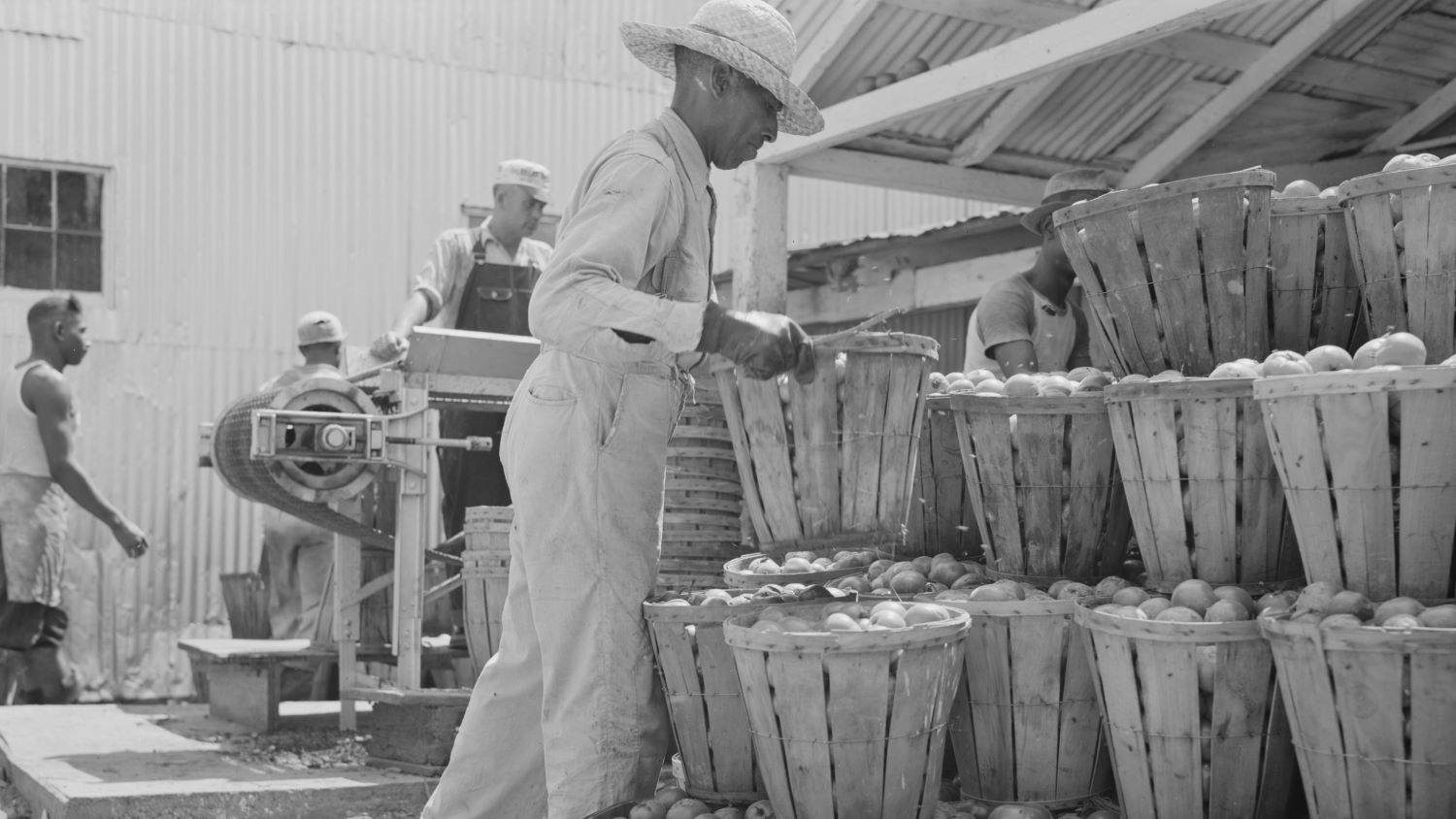Tomato Time
HISTORICAL PHOTOS FROM THE LIBRARY OF CONGRESS AND KATE LIVIE COLLECTION
In the little riverfront town of Crumpton, Maryland in the 1930’s, summer meant tomato time. Local fields were bursting with the red, ripe fruit, and on the waterfront the local cannery hired scores of workers and started up its steaming, thumping canning equipment. At high season, the river would be thickly red with tomato skins, dumped into the water and washed out with the tide. The entire community pitched in and got paid, including my grandfather and his whole family.
Throughout the Chesapeake region, in big cities like Baltimore and small towns like Crumpton, tomato packing was a way of life and a source of income every summer from the 19th century into the 20th. Today, the only parts of this seasonal industry to survive are the dilapidated husks of the old canneries, quietly collapsing along the Bay’s small tributaries. Most are already gone forever. But for three generations, canning operations big and small fed the country a miracle food—seasonless tomatoes.
It’s hard to imagine now, when tomatoes are in so many of the dishes we consider distinctly American, but tomatoes were Johnny-come-latelies to the American palate. One of the first foods—along with potatoes and peppers—from the New World to reach Europe after colonization, tomatoes took a while to catch on. A member of the nightshade family, tomatoes were embraced as an ornamental plant but treated with skepticism as a food. But eventually the Italians, French, and Spanish were won over by the tomato’s delicious versatility—the French, no surprise, insisted tomatoes were aphrodisiacs—and brought their recipes and demand for tomatoes with them as American immigrants in the early 19th century.
By the time that Mary Randolph included 17 recipes for tomato-based dishes in the 1824 edition of The Virginia House-Wife, American tomato mania was well underway. Tomatoes were the basis for sauces, soups, main and side dishes, and flavorful condiments like ketchup and marmalade. Snake oil salesmen even touted their health benefits and sold tomato pills. “In taking retrospect of the last 18 years,” commented one writer in 1858 of the tomato, “there is no vegetable on the catalogue that has obtained such popularity in so short a period…in ten years, almost every variety of pill and panacea was extract of tomato. It…is now cultivated the length and breadth of the country.”
But the growing season for tomatoes was frustratingly short, and fresh tomatoes, even when coaxed into early or late fruiting, were insufficient to meet the intense national demand.
Just as the 19th century tomato craze took off , new canning technology was developed in France and introduced to the US. Regionally, it first became widespread in the 1850’s as an oyster preservation method but was easily adapted to fruits and vegetables in the warmer seasons. The Mid Atlantic, with its long, sultry summers and rich soil, was an ideal location for cultivating all sorts of produce—peaches had a shining moment—but it was the growing, packing and shipping of tomatoes that made Delmarva famous.
Canneries popped up along the Chesapeake’s waterways and the new railroad lines, utilizing workboats, steamboats, and trains to transport fresh fruit or cans of summer tomatoes. Canning equipment was relatively inexpensive for enterprising would-be cannery operators, and even small Maryland towns like Crumpton, Trappe, Centreville, and Princess Anne all had operational canneries for decades. Caroline County alone had 62 small mom-and-pop canneries. The canneries were serviced by local farmers who transported their ripe crops to market in buyboats, skipjacks, farm carts, or later, trucks.
Labor, too, was mostly local and integrated—unusual in Jim-Crow-era Maryland, where small towns often were deeply segregated. When tomatoes came into season, farmers and canneries alike would hire local Black and white workers or in some cases, migrant labor, to pick the fruit, sort it, peel it, and can it. A peeler could earn $.05 a bucket in the 1920’s, and a skilled peeler might earn as much as $5 per day while tomatoes were in season. Gladys Jenkins, a peeler at Trappe’s Defender packing company, later said, “I always looked forward to tomato season, it was a time I could make a little money.”
In the early years of the tomato industry, there was no single kind of tomato grown for the canning market. Like apples, tomatoes were richly cultivated in a diverse range of colors and flavor profiles to suit different climates, growing and fruiting times, and taste preferences. Varieties like Red Rock, Greater Baltimore, Royal Red, Perfection, Paragon, and dozens of others were grown specifically for canning.
But there was increasingly an industry push to standardize the tomato—to reject the lumpy, bumpy, colorful diversity for a round, bright red, uniform fruit. In the quest to develop an “ideal” specimen, the canning industry set the narrow standard for what we expect of our tomatoes even today. Only in the last few decades have home gardeners pushed to bring back those delicious, unbeautiful varieties we almost lost along the way.
The tomato packing industry created several stand-out companies whose names we still recognize—Campbells Soup in New Jersey, which started out as a tomato cannery—and Phillips Seafood, once the canning juggernaut of the Chesapeake. Established in Cambridge, Maryland, in 1902, Phillips Packing and Seafood Company was the nucleus of a company town and one of the largest food processors in the nation. At its height during WWII, the business employed approximately a quarter of all Cambridge residents. Packing fruit, vegetables, oysters and crabs, the business was primarily known for tomato canning and ketchup, giving Cambridge the nickname, “tomato canning capital of the world.”
A 1922 Baltimore Sun article described the packing process at Phillips. “Wagons are driven up to the end of a machine in a tunnel-like casing. The ‘tomats’ are dumped from the basket to a perforated moving platform. They look very pretty as they move into a steaming wash. After the bath, they get a-boiling before a cold plunge helps their agony.” For the final stages of the process, “the tomatoes are dumped into wire baskets and given to skinners. After skinning, another cooking comes, then cans waiting in a long row. Cans are sealed as they pass by. When they are labeled and boxed the operation is complete.”
World War II spelled the last great era of tomato packing in the Chesapeake. Packinghouse production accelerated overnight to meet the armed forces’ enormous demand for shelf-stable food. The War Production Board released a statement: “There is a need for every case of tomatoes and peas that can be packaged in 1942.” Government ration contracts ultimately claimed 35% of Maryland’s tomato production. To meet the production demands during wartime when most workers were enlisted, canneries like Phillips hired women and, for the first time, non-US immigrant labor. Some tomato farms and packing houses were even allotted prisoners of war to supplement their labor force, like the 25 German POWs who worked for Talbot County’s Defender Packing Company.
The quest for a 12-month tomato growing season and the rise of frozen foods spelled the end of the Chesapeake’s tomato era. Tomato production began to decentralize, moving to California and later, Mexico. Consumer tastes were also changing, and fresh frozen vegetables and fruit were increasingly preferred over canned goods. For the region’s canneries, who lacked the capital for the costly upgrades needed to freeze and ship frozen food, it was the end. One by one, they shuttered, and fields that once produced tomatoes for the nation grew the corn, wheat and soybeans you see throughout the region today.
Phillips Packing and Seafood Company was one of the outlying survivors. As their canning business waned and was ultimately bought by Consolidated Foods, the family expanded into the seafood side of the business. Beginning with one Ocean City restaurant, Phillips would eventually become a leading name in the Chesapeake again—this time for their iconic seafood restaurants, packaged crab meat, and cans of crab soup.
Though the last remnants of Delmarva’s once-mighty tomato industry are gone, in the tomato town of Cambridge, Maryland, the history of the Phillips era lives on. Phillips Packing Plant F has been recently restored through a partnership between the Eastern Shore Land Conservancy and Cross Street Partners. Derelict for years, the space is now a light-filled community hub with restaurants, a microbrewery, an oyster bar, and a food and farming exchange. Its signature smokestack stands proudly over the town, a testament to the enduring legacy of Delmarva’s tomato golden age.
VISIT THE PACKING HOUSE
The Packing House
411A Dorchester Avenue
Cambridge, Maryland
Facebook























